When can you see the Northern Lights in Iceland?
By Michael Chapman
The Aurora Borealis remains among the top reasons to visit Iceland during winter.
Northern Lights season is between August and April in Iceland, co-aligned with the summer sun setting, and the incursion of long winter nights.
Guests will have a better chance of seeing the Northern Lights at their full potential deeper into the winter and should aim for visiting between September and March.
There are many reasons to choose Iceland for your Northern Lights experience, from our long nights to our wealth of dark and open spaces. Together, let us delve into the many reasons why experiencing the auroras in Iceland should be top of your bucket-list in 2021.
Northern Lights season is between August and April in Iceland, co-aligned with the summer sun setting, and the incursion of long winter nights.
Guests will have a better chance of seeing the Northern Lights at their full potential deeper into the winter and should aim for visiting between September and March.
There are many reasons to choose Iceland for your Northern Lights experience, from our long nights to our wealth of dark and open spaces. Together, let us delve into the many reasons why experiencing the auroras in Iceland should be top of your bucket-list in 2021.
What causes the Northern Lights?
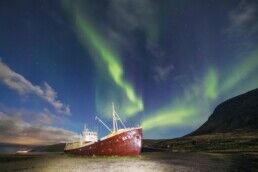
The Northern Lights result from a disturbed magnetosphere, a term which describes space around astronomical objects. When powerful solar winds buffer the magnetosphere, a tiny number of charged electrical particles enter the earth’s atmosphere at tremendous speed, clustering and concentrating at the North and South poles.
Due to their entry velocity, these particles will go through a process known as ionisation, which describes how an atom or molecule comes to be positively or negatively charged. As this change occurs, particles emit a plethora of colours (red, yellow, purple and green) which together make up the many shades of the Northern Lights.
Though you wouldn’t know it to look, the auroras are above us always, day-and-night, month-to-month; it is only we are incapable of seeing them unless conditions are just so.
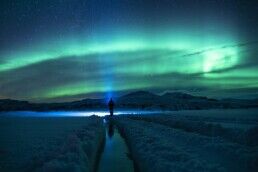
As mentioned, the auroras only appear in the Northern and Southern hemisphere, making their rare presence especially appealing for those living near the equator. Those in the south are the Aurora Australis, while those in the north are the Aurora Borealis.
There is no difference between the two phenomena save their location and fame; travellers can only see the Southern Lights from such remote areas that they are less widely spoken about than their northern cousins.
Without further ado, let’s take a look at the vital ingredients necessary to ensure you can witness the Northern Lights during your time in Iceland.
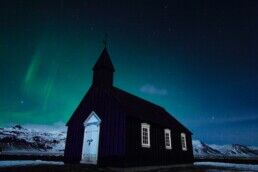
What causes the Northern Lights?

The Northern Lights result from a disturbed magnetosphere, a term which describes space around astronomical objects. When powerful solar winds buffer the magnetosphere, a tiny number of charged electrical particles enter the earth’s atmosphere at tremendous speed, clustering and concentrating at the North and South poles.
Due to their entry velocity, these particles will go through a process known as ionisation, which describes how an atom or molecule comes to be positively or negatively charged. As this change occurs, particles emit a plethora of colours (red, yellow, purple and green) which together make up the many shades of the Northern Lights.
Though you wouldn’t know it to look, the auroras are above us always, day-and-night, month-to-month; it is only we are incapable of seeing them unless conditions are just so.

As mentioned, the auroras only appear in the Northern and Southern hemisphere, making their rare presence especially appealing for those living near the equator. Those in the south are the Aurora Australis, while those in the north are the Aurora Borealis.
There is no difference between the two phenomena save their location and fame; travellers can only see the Southern Lights from such remote areas that they are less widely spoken about than their northern cousins.
Without further ado, let’s take a look at the vital ingredients necessary to ensure you can witness the Northern Lights during your time in Iceland.

What is needed to experience the Northern Lights in Iceland?
There are three significant prerequisites for catching the Northern Lights in Iceland. The first is clear and open skies, devoid of cloud cover or pesky light pollution. Northern Lights tend to form at higher altitudes than clouds, which means a blanket of grey overhead will stop your Northern Lights hunt dead in its tracks.
This brings us to our second requirement, total darkness, of which there is plenty to be found during the winter. If you escape from the city borders, you’ll find yourself quickly in Iceland’s wilderness, providing that perfect, untarnished black that is optimal for viewing the auroras. With it, you’ll have an excellent appreciation of just how nuanced the auroras’ colouring can be, including small pockets of grey and white.
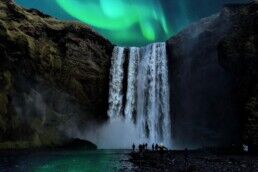
Finally, forecasters must predict high levels of solar activity on the night you hope to see the Northern Lights; otherwise, it is unlikely you’ll see anything but a blanket of stars above you. Before heading out, ensure you check the aurora forecasts predicted by the Icelandic Meteorological Office.
Bear in mind that even when each of these prerequisites are ticked off, there is no certainty the Northern Lights will appear where or when you want them too. While disappointing when it happens, it is their very elusiveness that has helped build such interest among travellers.
You might hear some misinformation during your travels that the Northern Lights are more likely to appear when the air temperature outside is colder. Such a claim is unequivocally false—except, of course, because their appearance is exclusive to the winter months—so don’t plan your excursion around what days are going to be warmer than others. Doing so will get you no closer to seeing the auroras.
What is needed to experience the Northern Lights in Iceland?
There are three significant prerequisites for catching the Northern Lights in Iceland. The first is clear and open skies, devoid of cloud cover or pesky light pollution. Northern Lights tend to form at higher altitudes than clouds, which means a blanket of grey overhead will stop your Northern Lights hunt dead in its tracks.
This brings us to our second requirement, total darkness, of which there is plenty to be found during the winter. If you escape from the city borders, you’ll find yourself quickly in Iceland’s wilderness, providing that perfect, untarnished black that is optimal for viewing the auroras. With it, you’ll have an excellent appreciation of just how nuanced the auroras’ colouring can be, including small pockets of grey and white.

Finally, forecasters must predict high levels of solar activity on the night you hope to see the Northern Lights; otherwise, it is unlikely you’ll see anything but a blanket of stars above you. Before heading out, ensure you check the aurora forecasts predicted by the Icelandic Meteorological Office.
Bear in mind that even when each of these prerequisites are ticked off, there is no certainty the Northern Lights will appear where or when you want them too. While disappointing when it happens, it is their very elusiveness that has helped build such interest among travellers.
You might hear some misinformation during your travels that the Northern Lights are more likely to appear when the air temperature outside is colder. Such a claim is unequivocally false—except, of course, because their appearance is exclusive to the winter months—so don’t plan your excursion around what days are going to be warmer than others. Doing so will get you no closer to seeing the auroras.
Top Locations in Iceland to Experience the Northern Lights
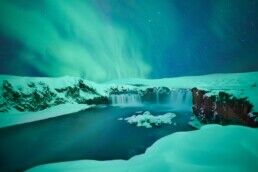
Iceland’s waterfalls, glacier lagoons, black sand beaches and lava fields all serve as fitting surroundings to look upon the Northern Lights. Photographers looking to capture stunning images of the Icelandic nature beneath the auroras will want to carefully research which locations they’ll want to spend the most time at so as not to miss their opportunity.
Exactly which location is best to see the Northern Lights in Iceland is more about personal preference than anything. Some will argue the iceberg dotted lagoon, Jökulsárlón, makes for the best setting, while others will swear by the stark fields of Lake Mývatn, or the windswept Dyrhólaey promenade or even Sólheimasandur plane wreck. What is clear is that wherever the Northern Lights appear, they compliment the Icelandic landscape no end.
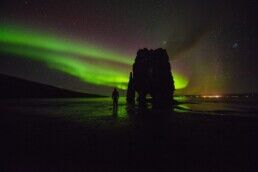
On average, the Northern Lights form around 100 kilometres above the earth’s surface, thus covering great swathes of the sky on appearance. This unpredictability can make knowing where to see the auroras a difficult task, and more often comes down to luck than research.
With that said, professional tour operators tend to know the country’s best spots to observe the lights at their fullest. If seeing the Northern Lights is something you feel you must do during your time in Iceland, booking a specially designed tour is your safest bet. Most times, your guides will take you out into the countryside in a 4×4 jeep, though there are also options to book Northern Lights cruises should that be preferable.
Top Locations in Iceland to Experience the Northern Lights

Iceland’s waterfalls, glacier lagoons, black sand beaches and lava fields all serve as fitting surroundings to look upon the Northern Lights. Photographers looking to capture stunning images of the Icelandic nature beneath the auroras will want to carefully research which locations they’ll want to spend the most time at so as not to miss their opportunity.
Exactly which location is best to see the Northern Lights in Iceland is more about personal preference than anything. Some will argue the iceberg dotted lagoon, Jökulsárlón, makes for the best setting, while others will swear by the stark fields of Lake Mývatn, or the windswept Dyrhólaey promenade or even Sólheimasandur plane wreck. What is clear is that wherever the Northern Lights appear, they compliment the Icelandic landscape no end.

On average, the Northern Lights form around 100 kilometres above the earth’s surface, thus covering great swathes of the sky on appearance. This unpredictability can make knowing where to see the auroras a difficult task, and more often comes down to luck than research.
With that said, professional tour operators tend to know the country’s best spots to observe the lights at their fullest. If seeing the Northern Lights is something you feel you must do during your time in Iceland, booking a specially designed tour is your safest bet. Most times, your guides will take you out into the countryside in a 4×4 jeep, though there are also options to book Northern Lights cruises should that be preferable.
Experience the Northern Lights in a Bubble hotel in Iceland
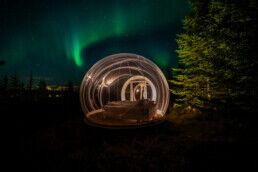
We would argue the best way to maximise the Northern Lights in Iceland is by choosing an overnight stay in one of our transparent bubbles. Designed to sleep two people, these cosy and unique spheres allow 360-degree views of both your surroundings and the sky, doubling up as your very own personal observatory.
Without worrying about the wind, cold, or having to get home on time, you are free to spend hour-upon-hour laying in bed looking up at the night sky. With all that time, you’ll feel less like you’re hunting the Northern Lights; more like you’re right there alongside them, an equal under the eyes of nature. In the meantime, you will have a full view of the cosmos, and it’s constellations and shooting stars.
Could a Northern Lights experience in Iceland get any better than this? Read more about Bubble hotels in Iceland on our informative FAQ page.
Experience the Northern Lights in a Bubble hotel in Iceland

We would argue the best way to maximise the Northern Lights in Iceland is by choosing an overnight stay in one of our transparent bubbles. Designed to sleep two people, these cosy and unique spheres allow 360-degree views of both your surroundings and the sky, doubling up as your very own personal observatory.
Without worrying about the wind, cold, or having to get home on time, you are free to spend hour-upon-hour laying in bed looking up at the night sky. With all that time, you’ll feel less like you’re hunting the Northern Lights; more like you’re right there alongside them, an equal under the eyes of nature. In the meantime, you will have a full view of the cosmos, and it’s constellations and shooting stars.
Could a Northern Lights experience in Iceland get any better than this? Read more about Bubble hotels in Iceland on our informative FAQ page.
How to Experience the Northern Lights in Reykjavik
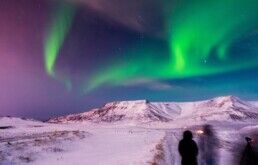
Yes, seeing the Northern Lights from Reykjavik is definitely a possibility. However, most advise against staying in the capital on account of the city lights. Light pollution can have a hugely adverse effect on the auroras’ vivacity, so it is always better to seek out far darker, more remote areas for your viewing pleasure.
Another issue with viewing the auroras from the city is that your view will likely be hampered by obtrusive buildings which can detract from the natural splendour above. Much better to find yourself somewhere wide and open, free of distractions and better-suited to viewing the night sky overall.
Nevertheless, there are a few places that can make for good Northern Lights viewing nearby to downtown. On the tip of the Seltjarnarnes Peninsula, Grótta lighthouse and nature reserve is widely known to be the go-to spot, offering a pitch-black coastline, and only minimal light pollution from nearby homes.
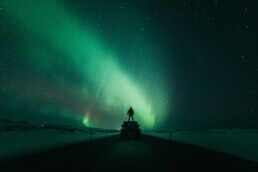
Another good location would be Heiðmörk conservation reserve, only six short miles from Reykjavik. Rich with vegetation and tree life, this gorgeous recreational area on the banks of Lake Elliðavatn provides enough distance from the city to see the Northern Lights without distraction.
If you happen to be unlucky during your visit, the Northern Lights may not appear at all. If this is the case, there are still a few places in the capital where you can get a sense of what this phenomenon is like.
Perlan Museum, for instance, is famed for its high-tech planetarium and Northern Lights in Iceland exhibition. At the same time, Aurora Reykjavík offers a range of art, information and theatre through its entertaining multimedia displays.
How to Experience the Northern Lights in Reykjavik

Yes, seeing the Northern Lights from Reykjavik is definitely a possibility. However, most advise against staying in the capital on account of the city lights. Light pollution can have a hugely adverse effect on the auroras’ vivacity, so it is always better to seek out far darker, more remote areas for your viewing pleasure.
Another issue with viewing the auroras from the city is that your view will likely be hampered by obtrusive buildings which can detract from the natural splendour above. Much better to find yourself somewhere wide and open, free of distractions and better-suited to viewing the night sky overall.
Nevertheless, there are a few places that can make for good Northern Lights viewing nearby to downtown. On the tip of the Seltjarnarnes Peninsula, Grótta lighthouse and nature reserve is widely known to be the go-to spot, offering a pitch-black coastline, and only minimal light pollution from nearby homes.

Another good location would be Heiðmörk conservation reserve, only six short miles from Reykjavik. Rich with vegetation and tree life, this gorgeous recreational area on the banks of Lake Elliðavatn provides enough distance from the city to see the Northern Lights without distraction.
If you happen to be unlucky during your visit, the Northern Lights may not appear at all. If this is the case, there are still a few places in the capital where you can get a sense of what this phenomenon is like.
Perlan Museum, for instance, is famed for its high-tech planetarium and Northern Lights in Iceland exhibition. At the same time, Aurora Reykjavík offers a range of art, information and theatre through its entertaining multimedia displays.
When should I hunt the auroras in Iceland?
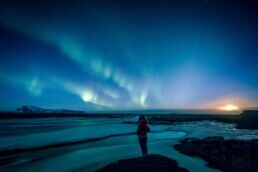
If you’re planning on hunting the Northern Lights in Iceland, leave in the early evening so you can arrive at the most-prized observation spots in good time. Between September and March, it is assured the darkness will have swept in by 6 PM, which leaves plenty of space for travelling to, and waiting for, the lights on site.
Given this window, it’s highly recommended you grab some food at one of Reykjavik’s many fine dining establishments before venturing out, not only so that you’re well-fed during the experience, but also to provide the perfect social opening to your Northern Lights adventure.
When should I hunt the auroras in Iceland?

If you’re planning on hunting the Northern Lights in Iceland, leave in the early evening so you can arrive at the most-prized observation spots in good time. Between September and March, it is assured the darkness will have swept in by 6 PM, which leaves plenty of space for travelling to, and waiting for, the lights on site.
Given this window, it’s highly recommended you grab some food at one of Reykjavik’s many fine dining establishments before venturing out, not only so that you’re well-fed during the experience, but also to provide the perfect social opening to your Northern Lights adventure.
Other useful tips about the Northern Lights in Iceland
There are a few other useful tips to keep in mind when hunting the Northern Lights in Iceland, the most important of which is to try and book your excursion as early into your holiday as possible. This way, you will have more opportunity to spot them as your time in Iceland progresses, and may even be able to jump on a rescheduled tour.
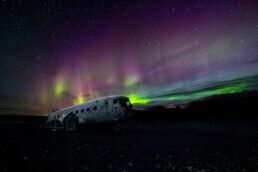
Another handy tip is to make sure you avoid any dates where a full moon is present in the sky. This is a bit of a contentious issue, as photographers find capturing an image of both the moon and Northern Lights appealing, and many will argue that the risks are overblown. While you might think it picturesque, the moon’s brightness can go a long way in diluting the intensity of the auroras, sapping the experience of its true potential. Don’t say you weren’t warned!
When it comes to dressing yourself, you’ll want to make sure you’re wearing several thermal layers to protect from the cold. A waterproof and windproof jacket is always a good idea, as are sturdy hiking boots capable of traversing rough terrain (—after all, who knows which patch of darkness you’ll choose to visit?). Gloves, scarves and hats are necessary for winter, so should not be forgotten before heading out into the wilderness at night.
Iceland is not the only country in the world where you can witness the auroras in action. The Northern Lights can be observed in North Canada and Alaska, as well as Norway, Finland, Sweden and Greenland. On the other hand, those fortunate enough to see them can observe the Southern Lights in Tasmania, New Zealand, Australia, Chile, and Argentina.
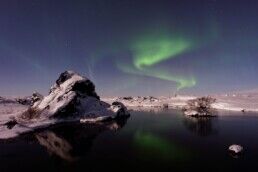
This tip is solely for loyal trivia fans. The Northern Lights’ scientific term is named after Aurora, the Roman Goddess of dawn, frost and dew, whereas the Greeks knew her as Eos. Borealis is the Greek term for the north wind. Whilst not a practical bit of information, per se, you’ll undoubtedly impress your travelling party with knowledgeable tidbits on the subject at hand.
In the absence of science, ancient people speculated the Northern Lights in Iceland were the glint that shone from the armour of mythic Valkyries, goddess-warriors who shepherded souls to Valhalla. There have been many other theories across the ages; Native Americans believed the lights to be a form of communication with the spirit ancestors, whereas the Finnish Sami believed they were the sparks created by snow foxes running across the landscape.
In short, experiencing the Northern Lights in Iceland is something that every traveller should aspire to. With their breathtaking ambience, vivid colourisation and lively disposition, the Aurora Borealis is a natural phenomenon with no rival, and as such, will long remain one of Iceland’s greatest pulls for visitors overseas.
Other useful tips about the Northern Lights in Iceland
There are a few other useful tips to keep in mind when hunting the Northern Lights in Iceland, the most important of which is to try and book your excursion as early into your holiday as possible. This way, you will have more opportunity to spot them as your time in Iceland progresses, and may even be able to jump on a rescheduled tour.

Another handy tip is to make sure you avoid any dates where a full moon is present in the sky. This is a bit of a contentious issue, as photographers find capturing an image of both the moon and Northern Lights appealing, and many will argue that the risks are overblown. While you might think it picturesque, the moon’s brightness can go a long way in diluting the intensity of the auroras, sapping the experience of its true potential. Don’t say you weren’t warned!
When it comes to dressing yourself, you’ll want to make sure you’re wearing several thermal layers to protect from the cold. A waterproof and windproof jacket is always a good idea, as are sturdy hiking boots capable of traversing rough terrain (—after all, who knows which patch of darkness you’ll choose to visit?). Gloves, scarves and hats are necessary for winter, so should not be forgotten before heading out into the wilderness at night.
Iceland is not the only country in the world where you can witness the auroras in action. The Northern Lights can be observed in North Canada and Alaska, as well as Norway, Finland, Sweden and Greenland. On the other hand, those fortunate enough to see them can observe the Southern Lights in Tasmania, New Zealand, Australia, Chile, and Argentina.

This tip is solely for loyal trivia fans. The Northern Lights’ scientific term is named after Aurora, the Roman Goddess of dawn, frost and dew, whereas the Greeks knew her as Eos. Borealis is the Greek term for the north wind. Whilst not a practical bit of information, per se, you’ll undoubtedly impress your travelling party with knowledgeable tidbits on the subject at hand.
In the absence of science, ancient people speculated the Northern Lights in Iceland were the glint that shone from the armour of mythic Valkyries, goddess-warriors who shepherded souls to Valhalla. There have been many other theories across the ages; Native Americans believed the lights to be a form of communication with the spirit ancestors, whereas the Finnish Sami believed they were the sparks created by snow foxes running across the landscape.
In short, experiencing the Northern Lights in Iceland is something that every traveller should aspire to. With their breathtaking ambience, vivid colourisation and lively disposition, the Aurora Borealis is a natural phenomenon with no rival, and as such, will long remain one of Iceland’s greatest pulls for visitors overseas.